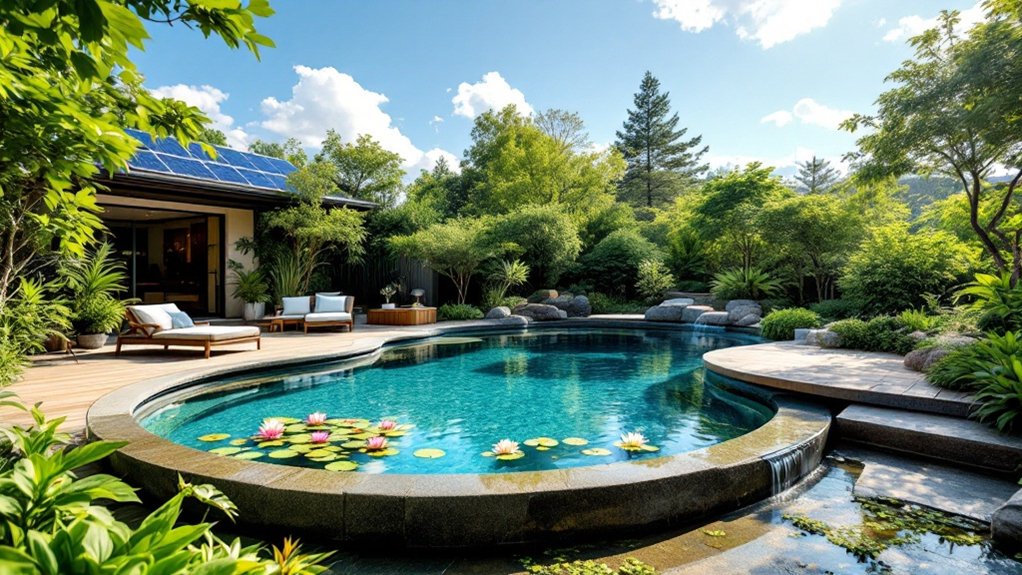Investing in a low-impact pool design presents a strategic choice for homeowners. These pools align with sustainable practices, offering environmental benefits while promoting water and energy conservation. Additionally, they enhance property aesthetics and value. The integration of natural elements and advanced technologies raises questions about long-term impacts. Understanding the nuances of this investment may lead to surprising insights into both personal enjoyment and ecological responsibility. What aspects should one consider before making such a decision?
Understanding Low-Impact Pool Design
While traditional pool designs often prioritize aesthetic appeal and size, low-impact pool design focuses on sustainability and environmental harmony. This innovative approach integrates natural elements and eco-friendly materials, emphasizing reduced energy consumption and minimal ecological disruption. Low-impact pools often feature designs that blend seamlessly into the landscape, utilizing native plants and natural filtration systems to maintain water quality. The construction methods are typically less invasive, preserving existing ecosystems and minimizing soil erosion. Additionally, low-impact pools prioritize efficient water usage, often incorporating rainwater harvesting systems to reduce dependency on municipal water supplies. By prioritizing functionality alongside environmental responsibility, low-impact pool design represents a shift towards more sustainable practices in recreational water features, appealing to environmentally conscious homeowners.
Environmental Benefits of Low-Impact Pools
Low-impact pools offer significant environmental advantages through innovative design strategies. These pools incorporate water conservation techniques, utilize eco-friendly materials, and employ natural filtration systems, all of which contribute to reduced ecological footprints. By focusing on sustainability, low-impact pools demonstrate a commitment to protecting natural resources while enhancing recreational spaces.
Water Conservation Techniques
Numerous water conservation techniques can greatly enhance the environmental benefits of low-impact pool designs. One effective method is the integration of rainwater harvesting systems, which collect and store rainwater for pool filling and maintenance, reducing reliance on municipal water sources. Additionally, implementing efficient circulation systems minimizes evaporation and water loss, while using pool covers during non-use periods can markedly decrease evaporation rates. Employing native landscaping around the pool can also promote water retention in the surrounding environment, reducing runoff. Moreover, incorporating advanced filtration systems can improve water quality, allowing for less frequent water changes. By utilizing these techniques, low-impact pools not only conserve water but also contribute to sustainable water management practices, reinforcing their overall environmental value.
Eco-Friendly Materials Utilization
As the demand for sustainable construction practices increases, the use of eco-friendly materials in pool design has become a key factor in enhancing the environmental benefits of low-impact pools. Utilizing materials such as recycled glass, bamboo, and non-toxic sealants minimizes the carbon footprint associated with traditional pool construction. These sustainable options not only reduce resource depletion but also promote healthier ecosystems by decreasing harmful chemical runoff. Additionally, eco-friendly materials often have longer lifespans, resulting in less frequent replacements and reduced waste. Incorporating permeable surfaces can improve drainage and mitigate erosion, further contributing to environmental preservation. Overall, the integration of eco-friendly materials in low-impact pool design exemplifies a commitment to sustainability while creating aesthetically pleasing and functional outdoor spaces.
Natural Filtration Systems
The integration of natural filtration systems in pool design greatly enhances the environmental benefits associated with low-impact pools. These systems utilize biological processes, often involving plants and microorganisms, to purify water without relying on harsh chemicals. By mimicking natural ecosystems, they promote biodiversity and provide habitats for local wildlife. Additionally, natural filtration systems markedly reduce water consumption, as they require less frequent chemical balancing and water replacement. This sustainable approach also minimizes the carbon footprint associated with traditional pool maintenance, contributing to a healthier environment. Moreover, the aesthetic appeal of lush plant life enhances the pool’s surroundings, creating a serene atmosphere that encourages outdoor enjoyment while promoting ecological responsibility. Overall, natural filtration systems represent a harmonious balance between leisure and environmental stewardship.
Water Conservation Strategies
Although water is an essential resource for maintaining a thriving pool environment, effective water conservation strategies can greatly reduce usage and promote sustainability. Implementing rainwater harvesting systems allows pool owners to collect and utilize natural precipitation, minimizing reliance on municipal water sources. Additionally, incorporating water-efficient pool covers can markedly reduce evaporation, preserving water during both active use and downtime. Regular maintenance, such as checking for leaks and ensuring ideal filtration efficiency, further helps to minimize unnecessary water loss. Choosing drought-resistant landscaping around the pool area can also reduce the overall demand for water. By adopting these strategies, pool owners can create an eco-friendly environment that supports both recreational enjoyment and responsible resource management. Furthermore, maintaining clean pipes is crucial for optimizing water circulation and preventing waste.
Energy Efficiency and Cost Savings
Energy efficiency in low-impact pool design greatly contributes to reduced energy consumption and lower maintenance expenses. These pools often incorporate sustainable design elements that not only enhance their ecological footprint but also result in long-term cost savings for owners. In this way, a focus on energy-efficient practices can lead to both environmental benefits and financial advantages. Additionally, incorporating features such as energy efficiency ratings can further optimize resource usage and minimize operational costs.
Reduced Energy Consumption
By incorporating advanced technologies and sustainable materials, low-impact pool designs greatly reduce energy consumption, resulting in both environmental benefits and cost savings for owners. These pools utilize energy-efficient pumps, heaters, and lighting systems that consume less power than traditional options. Solar heating systems further enhance energy efficiency by harnessing renewable resources, significantly lowering reliance on fossil fuels. Additionally, the strategic placement of pool features minimizes heat loss and optimizes water circulation, ensuring that energy is used effectively. This reduction in energy consumption not only decreases utility bills but also lessens the overall carbon footprint associated with pool ownership. Consequently, low-impact pool designs align with modern sustainability goals while offering financial incentives for conscientious consumers.
Lower Maintenance Expenses
Affordability in pool ownership is greatly enhanced through low-impact designs that lower maintenance expenses. These innovative pools often require fewer chemicals and less frequent cleaning, considerably reducing ongoing costs. The materials and construction methods used in low-impact designs are typically more durable, which translates to fewer repairs and replacements over time. Additionally, energy-efficient pumps and filtration systems contribute to lower utility bills, making maintenance more manageable. The reduced need for maintenance not only saves money but also lessens the time and effort owners invest in pool upkeep. Consequently, adopting low-impact pool designs offers a financially viable solution for pool owners seeking to minimize expenses while still enjoying the benefits of a swimming pool.
Sustainable Design Benefits
Low-impact pool designs not only reduce maintenance costs but also emphasize sustainability through energy-efficient features. These pools incorporate advanced technologies such as solar heating, LED lighting, and efficient filtration systems, considerably lowering energy consumption. By utilizing natural materials and minimizing chemical use, they further contribute to environmental health. The design often includes landscaping that promotes natural filtration, reducing the need for excessive water and chemical treatments. Additionally, a well-designed low-impact pool can enhance property value and attract eco-conscious buyers. Over time, the initial investment in energy-efficient systems can lead to substantial cost savings, making these pools a financially sound choice for environmentally aware homeowners. The long-term benefits align with growing concerns about sustainability and resource conservation.
Eco-Friendly Materials and Construction
As the demand for sustainable living increases, the choice of eco-friendly materials and construction methods in pool design becomes essential. Utilizing recycled or sustainably sourced materials, such as reclaimed wood, natural stone, and low-impact concrete, can greatly reduce environmental footprints. Additionally, incorporating energy-efficient technologies, like solar-powered heating systems and LED lighting, minimizes energy consumption. Advanced filtration systems that use fewer chemicals promote cleaner water while safeguarding local ecosystems. The use of permeable surfaces also enhances water management by reducing runoff and promoting groundwater recharge. By focusing on eco-friendly construction practices, designers create pools that not only blend harmoniously with nature but also contribute positively to the environment, ensuring that future generations can enjoy these resources.
Enhancing Aesthetic Appeal and Property Value
While the primary function of a pool is often recreation, its design can greatly enhance the aesthetic appeal of a property and increase its market value. A well-designed low-impact pool harmonizes with the surrounding landscape, creating a visually striking focal point. Incorporating natural materials and unique shapes can elevate the overall design, making a home more inviting and luxurious. Features such as integrated landscaping, water features, and eco-friendly lighting can further enhance visual appeal. Additionally, a thoughtfully designed pool can attract potential buyers, as it reflects a commitment to sustainability and modern living. Ultimately, investing in an aesthetically pleasing low-impact pool design not only enriches the property’s ambiance but also serves as a strategic investment in its future value. Furthermore, careful planning and consultation can ensure that the pool design is tailored to fit seamlessly within the existing landscape and meets local regulations.
Maintenance Considerations for Sustainable Pools
Although sustainable pools offer numerous environmental benefits, their maintenance requires careful consideration to guarantee long-term efficiency and health. Regular cleaning is essential to prevent algae growth and maintain water clarity, often necessitating less harsh chemicals than traditional pools. Monitoring water quality, particularly pH levels and chlorine concentrations, is critical for ensuring a safe swimming environment. Sustainable pools may also utilize eco-friendly filtration systems, which require specific upkeep to function effectively. Additionally, the surrounding landscaping should be designed to minimize debris and runoff, reducing the need for frequent maintenance. Regular inspections of pumps, heaters, and other equipment help identify potential issues early, enhancing the pool’s sustainability and longevity. Therefore, appropriate maintenance is essential for maximizing the benefits of sustainable pool designs. Regular checks for sharp objects help further ensure a safe swimming environment.
Frequently Asked Questions
How Do Low-Impact Pools Compare to Traditional Pools in Size?
Low-impact pools typically feature smaller dimensions compared to traditional pools, maximizing space efficiency. Their design often prioritizes shallow areas and compact layouts, catering to users seeking a more accessible and environmentally friendly aquatic experience.
Can I Retrofit an Existing Pool to a Low-Impact Design?
Retrofitting an existing pool to a low-impact design is feasible, depending on the current structure and layout. Modifications may include adjusting depth, improving circulation systems, and incorporating natural filtration elements for enhanced sustainability and efficiency.
What Is the Lifespan of a Low-Impact Pool?
The lifespan of a low-impact pool typically ranges from 15 to 30 years, depending on factors such as materials used, maintenance practices, and environmental conditions, which all play essential roles in its durability and longevity.
Are Low-Impact Pools Suitable for All Climates?
Low-impact pools are generally suitable for various climates, though specific designs may require adaptations. Proper insulation, heating options, and materials can enhance their functionality in colder regions, while maintenance considerations are essential in warmer climates.
What Permits Are Needed for Building a Low-Impact Pool?
Building a low-impact pool typically requires permits related to zoning, construction, and environmental considerations. Local regulations may dictate specific requirements, including site plans and inspections, ensuring compliance with safety and ecological standards throughout the construction process.
Conclusion
Investing in a low-impact pool design offers a multitude of benefits that align with sustainable living. By prioritizing environmental considerations, these pools not only conserve water and energy but also enhance property value and aesthetic appeal. Homeowners can enjoy the recreational advantages of a pool while minimizing their ecological footprint. Ultimately, low-impact pools represent a responsible choice for those seeking to balance luxury with environmental stewardship, fostering a harmonious relationship with nature.




